The Life Histories of Intermediate Hosts and Parasites of Schistosoma haematobium and Schistosoma mansoni in the White Nile River, Sudan
Abstract
1. Introduction
2. Materials and Methods
2.1. Collection and Identification of Snails
2.2. Natural Infections of the Snails
2.3. Identification of Cercariae
2.4. Snail Maintenance and Breeding
2.5. Fecundity, Size, and Survival Rate of Snails
2.5.1. First Generation of Snails
2.5.2. Infection of B. pfeifferi Snails
2.6. Cercarial Rhythmicity
2.7. Ethical Clearance
2.8. Statistical Analysis
3. Results
3.1. Diurnal Rhythmicity and Production of Cercariae
3.2. Comparison of Survival, Fecundity, and Growth between Infected and Non-Infected Snails
4. Discussion
5. Conclusions
Author Contributions
Funding
Institutional Review Board Statement
Informed Consent Statement
Data Availability Statement
Conflicts of Interest
References
- WHO. Factsheet/Schistosomiasis; World Health Organization: Geneva, Switzerland, 2021; Available online: https://www.who.int/news-room/fact-sheets/detail/schistosomiasis (accessed on 30 November 2021).
- WHO. Global Health Estimates 2016: Deaths by Cause, Age, Sex, by Country and by Region, 2000–2016; World Health Organization: Geneva, Switzerland, 2019. [Google Scholar]
- WHO. Prevention and Control of Schistosomiasis and Soil-Transmitted Helminthiasis (WHO/CDS/CPE/PVC/2004.9); World Health Organization: Geneva, Switzerland, 2004. [Google Scholar]
- van der Werf, M.J.; de Vlas, S.J.; Brooker, S.; Looman, C.W.; Nagelkerke, N.J.; Habbema, J.D.; Engels, D. Quantification of clinical morbidity associated with schistosome infection in sub-Saharan Africa. Acta Trop. 2003, 86, 125–139. [Google Scholar] [CrossRef]
- Sturrock, H.J.; Picon, D.; Sabasio, A.; Oguttu, D.; Robinson, E.; Lado, M.; Rumunu, J.; Brooker, S.; Kolaczinski, J.H. Integrated mapping of neglected tropical diseases: Epidemiological findings and control implications for northern Bahr-el-Ghazal State, Southern Sudan. PLoS Negl. Trop. Dis. 2009, 3, e537. [Google Scholar] [CrossRef] [PubMed]
- Finn, T.P.; Stewart, B.T.; Reid, H.L.; Petty, N.; Sabasio, A.; Oguttu, D.; Lado, M.; Brooker, S.J.; Kolaczinski, J.H. Integrated rapid mapping of neglected tropical diseases in three States of South Sudan: Survey findings and treatment needs. PLoS ONE 2012, 7, e52789. [Google Scholar] [CrossRef]
- Utzinger, J.; Bergquist, R.; Shu-Hua, X.; Singer, B.H.; Tanner, M. Sustainable schistosomiasis control—The way forward. Lancet 2003, 362, 1932–1934. [Google Scholar] [CrossRef]
- King, C.H.; Dickman, K.; Tisch, D.J. Reassessment of the cost of chronic helmintic infection: A meta-analysis of disability-related outcomes in endemic schistosomiasis. Lancet 2005, 365, 1561–1569. [Google Scholar] [CrossRef]
- World Bank. World Development Report 1993: Investing in Health; Oxford University Press: Oxford, UK, 1993; pp. 1–329. [Google Scholar]
- Liu, C.; Luo, R.; Yi, H.; Zhang, L.; Li, S.; Bai, Y.; Medina, A.; Rozelle, S.; Smith, S.; Wang, G.; et al. Soil-Transmitted Helminths in Southwestern China: A Cross-Sectional Study of Links to Cognitive Ability, Nutrition, and School Performance among Children. PLoS Negl. Trop. Dis. 2015, 9, e0003877. [Google Scholar] [CrossRef] [PubMed][Green Version]
- Lo, N.C.; Snyder, J.; Addiss, D.G.; Heft-Neal, S.; Andrews, J.R.; Bendavid, E. Deworming in pre-school age children: A global empirical analysis of health outcomes. PLoS Negl. Trop. Dis. 2018, 12, e0006500. [Google Scholar] [CrossRef] [PubMed]
- Ramírez-Carrillo, E.; Gaona, O.; Nieto, J.; Sánchez-Quinto, A.; Cerqueda-García, D.; Falcón, L.I.; Rojas-Ramos, O.A.; González-Santoyo, I. Disturbance in human gut microbiota networks by parasites and its implications in the incidence of depression. Sci. Rep. 2020, 10, 3680. [Google Scholar] [CrossRef]
- Zu, D.L.; Wang, X.H.; Wang, J.B.; Zhuge, Y. Cross-sectional survey between schistosomiasis liver fibrosis and health-related quality of life among agricultural workers. Zhonghua Lao Dong Wei Sheng Zhi Ye Bing Za Zhi 2021, 39, 434–437. [Google Scholar]
- Roriz, S.J.; Pereira, T.A.; Vaz de Melo Trindade, G.; Caporali, J.F.M.; Lambertucci, J.R. Quality of Life Assessment Among Patients Living With Hepatosplenic Schistosomiasis and Schistosomal Myeloradiculopathy. Front. Med. 2021, 8, 629484. [Google Scholar] [CrossRef]
- Ouattara, M.; Diakité, N.R.; Yao, P.K.; Saric, J.; Coulibaly, J.T.; Assaré, R.K.; Bassa, F.K.; Koné, N.; Guindo-Coulibaly, N.; Hattendorf, J.; et al. Effectiveness of school-based preventive chemotherapy strategies for sustaining the control of schistosomiasis in Côte d’Ivoire: Results of a 5-year cluster randomized trial. PLoS Negl. Trop. Dis. 2021, 15, e0008845. [Google Scholar] [CrossRef] [PubMed]
- Lenk, E.J.; Redekop, W.K.; Luyendijk, M.; Rijnsburger, A.J.; Severens, J.L. Productivity Loss Related to Neglected Tropical Diseases Eligible for Preventive Chemotherapy: A Systematic Literature Review. PLoS Negl. Trop. Dis. 2016, 10, e0004397. [Google Scholar] [CrossRef] [PubMed]
- Inobaya, M.T.; Olveda, R.M.; Chau, T.N.; Olveda, D.U.; Ross, A.G. Prevention and control of schistosomiasis: A current perspective. Res. Rep. Trop. Med. 2014, 2014, 65–75. [Google Scholar] [PubMed]
- Lu, D.B.; Wang, T.P.; Rudge, J.W.; Donnelly, C.A.; Fang, G.R.; Webster, J.P. Evolution in a multi-host parasite: Chronobiological circadian rhythm and population genetics of Schistosoma japonicum cercariae indicates contrasting definitive host reservoirs by habitat. Int. J. Parasitol. 2009, 39, 1581–1588. [Google Scholar] [CrossRef] [PubMed]
- Mouahid, G.; Mintsa Nguema, R.; Al Mashikhi, K.M.; Al Yafae, S.A.; Idris, M.A.; Moné, H. Host-parasite life-histories of the diurnal vs. nocturnal chronotypes of Schistosoma mansoni: Adaptive significance. Trop. Med. Int. Health. 2019, 24, 692–700. [Google Scholar] [CrossRef] [PubMed]
- Whitfield, P.J.; Bartlett, A.; Khammo, N.; Clothier, R.H. Age-dependent survival and infectivity of Schistosoma mansoni cercariae. Parasitology 2003, 127, 29–35. [Google Scholar] [CrossRef]
- Yousif, F.; Roushdy, M.; Ibrahim, A.; el Hommossany, K.; Shiff, C. Cercariometry in the study of Schistosoma mansoni transmission in Egypt. J. Egypt Soc. Parasitol. 1996, 26, 353–365. [Google Scholar]
- Colley, D.G.; Bustinduy, A.L.; Secor, W.E.; King, C.H. Human schistosomiasis. Lancet 2014, 383, 2253–2264. [Google Scholar] [CrossRef]
- Ismail, H.A.; Abed el Aziz, A.; Ahmed, Y.H.L.; Elhag, M.S.; Kim, Y.; Cha, S.; Jin, Y. Population Dynamics of Intermediate-Host Snails in the White Nile River, Sudan: A Year-Round Observational Descriptive Study. Korean J. Parasitol. 2021, 59, 121–129. [Google Scholar] [CrossRef]
- Mandahl-Barth, G. A Field Guide to African Freshwater Snails. 2. East African Species; Danish Bilharziasis Laboratory: Charlottenlund, Denmark, 1989. [Google Scholar]
- Frandsen, F.; Christensen, N.O. An introductory guide to the identification of cercariae from African freshwater snails with special reference to cercariae of trematode species of medical and veterinary importance. Acta Trop. 1984, 41, 181–202. [Google Scholar]
- Ahmed, A.A.; Ibrahim, N.A.; Idris, M.A. Laboratory Studies on the Prevalence and Cercarial Rhythms of Trematodes from Bulinus truncatus and Biomphalaria pfeifferi Snails from Khartoum State, Sudan. Sultan Qaboos Univ. Med. J. 2006, 6, 65–69. [Google Scholar] [PubMed]
- Steinauer, M.L.; Mwangi, I.N.; Maina, G.M.; Kinuthia, J.M.; Mutuku, M.W.; Agola, E.L.; Mungai, B.; Mkoji, G.M.; Loker, E.S. Interactions between natural populations of human and rodent schistosomes in the Lake Victoria region of Kenya: A molecular epidemiological approach. PLoS Negl. Trop. Dis. 2008, 2, e222. [Google Scholar] [CrossRef] [PubMed]
- Théron, A.; Moné, H. Shedding patterns of Schistosoma mansoni and Ribeiroia marini cercariae from a mixed infection of Biomphalaria glabrata. J. Helminthol. 1986, 60, 255–259. [Google Scholar] [CrossRef] [PubMed]
- Théron, A. Early and late shedding patterns of Schistosoma mansoni cercariae: Ecological significance in transmission to human and murine hosts. J. Parasitol. 1984, 70, 652–655. [Google Scholar] [CrossRef] [PubMed]
- Mouchet, F.; Théron, A.; Brémond, P.; Sellin, E.; Sellin, B. Pattern of cercarial emergence of Schistosoma curassoni from Niger and comparison with three sympatric species of schistosomes. J. Parasitol. 1992, 78, 61–63. [Google Scholar] [CrossRef]
- Combes, C.; Fournier, A.; Moné, H.; Théron, A. Behaviours in trematode cercariae that enhance parasite transmission: Patterns and processes. Parasitology 1994, 109, S3–S13. [Google Scholar] [CrossRef]
- N’Goran, E.; Brémond, P.; Sellin, E.; Sellin, B.; Théron, A. Intraspecific diversity of Schistosoma haematobium in west Africa: Chronobiology of cercarial emergence. Acta Trop. 1997, 66, 35–44. [Google Scholar] [CrossRef]
- Rowan, W.B. Daily periodicity of Schistosoma mansoni cercariae in Puerto Rican water. Am. J. Trop. Med. Hyg. 1958, 7, 374–381. [Google Scholar] [CrossRef]
- Kloos, H.; Gardiner, C.H.; Selim, A.; Higashi, G.I. Laboratory andfieldevaluation of a direct filtration technique for recovery of schistosome cercariae. Am. J. Trop. Med. Hyg. 1982, 31, 122–127. [Google Scholar] [CrossRef]
- Sato, K.; Noda, S.; Katsumata, T.; Muhoho, N.D.; Aoki, Y. Epidemiological studies on Schistosoma haematobium infection in Coastal area of Kenya. Diurnal fluctuation of cercarial density in natural water and measurement of the risk of infection after control by cercariometry. Trop. Med. 1987, 29, 81–85. [Google Scholar]
- Grimes, J.E.; Croll, D.; Harrison, W.E.; Utzinger, J.; Freeman, M.C.; Templeton, M.R. The roles of water, sanitation and hygiene in reducing schistosomiasis: A review. Parasites Vectors 2015, 8, 156. [Google Scholar] [CrossRef] [PubMed]
- Mintsa-Nguéma, R.; Moné, H.; Ibikounlé, M.; Mengué-Ngou-Milama, K.; Kombila, M.; Mouahid, G. Cercarial emergence pattern of Schistosoma haematobium from Libreville, Gabon. Parasite 2014, 21, 3. [Google Scholar] [CrossRef] [PubMed]
- Ibikounle, M.; Mone, H.; Abou, Y.; Kinde-Gazard, D.; Sakiti, N.G.; Mouahid, G.; Massougbodji, A. Premier cas d’émission cercarienne de type infradien chez Schistosoma mansoni dans deux foyers du sud-Bénin. Int. J. Biol. Chem. Sci. 2012, 6, 1081–1089. [Google Scholar]
- Wolmarans, C.T.; de Kock, K.N.; Strauss, H.D.; Bornman, M. Daily emergence of Schistosoma mansoni and S. haematobium cercariae from naturally infected snails under field conditions. J. Helminthol. 2002, 76, 273–277. [Google Scholar] [CrossRef] [PubMed]
- Lelo, A.E.; Mburu, D.N.; Magoma, G.N.; Mungai, B.N.; Kihara, J.H.; Mwangi, I.N.; Maina, G.M.; Kinuthia, J.M.; Mutuku, M.W.; Loker, E.S.; et al. No apparent reduction in schistosome burden or genetic diversity following four years of school-based mass drug administration in mwea, central kenya, a heavy transmission area. PLoS Negl. Trop. Dis. 2014, 8, e3221. [Google Scholar] [CrossRef]
- Lu, X.T.; Gu, Q.Y.; Limpanont, Y.; Song, L.G.; Wu, Z.D.; Okanurak, K.; Lv, Z.Y. Snail-borne parasitic diseases: An update on global epidemiological distribution, transmission interruption and control methods. Infect. Dis. Poverty 2018, 7, 28. [Google Scholar] [CrossRef]
- Tchuem Tchuenté, L.A.; Rollinson, D.; Stothard, J.R.; Molyneux, D. Moving from control to elimination of schistosomiasis in sub-Saharan Africa: Time to change and adapt strategies. Infect. Dis. Poverty 2017, 6, 42. [Google Scholar] [CrossRef]
- King, C.H.; Sutherland, L.J.; Bertsch, D. Systematic Review and Meta-analysis of the Impact of Chemical-Based Mollusciciding for Control of Schistosoma mansoni and S. haematobium Transmission. PLoS Negl. Trop. Dis. 2015, 9, e0004290. [Google Scholar] [CrossRef]
- Hilali, A.M.; Desouqi, L.A.; Wassila, M.; Daffalla, A.A.; Fenwick, A. Snails and aquatic vegetation in Gezira irrigation canals. J. Trop. Med. Hyg. 1985, 88, 75–81. [Google Scholar]
- Hilali, A.H.; Madsen, H.; Daffalla, A.A.; Wassila, M.; Christensen, N.O. Infection and transmission pattern of Schistosoma mansoni in the Managil irrigation scheme, Sudan. Ann. Trop. Med. Parasitol. 1995, 89, 279–286. [Google Scholar] [CrossRef]
- Amin, M.; Abubaker, H. Control of schistosomiasis in the Gezira irrigation scheme, Sudan. J. Biosoc. Sci. 2017, 49, 83–98. [Google Scholar] [CrossRef] [PubMed]
- Fenwick, A.; Cheesmond, A.K.; Amin, M.A. The role of field irrigation canals in the transmission of Schistosoma mansoni in the Gezira Scheme, Sudan. Bull. World Health Organ. 1981, 59, 777–786. [Google Scholar] [PubMed]
- Mohammed, N.A.; Madsen, H.; Ahmed, A.A. Types of trematodes infecting freshwater snails found in irrigation canals in the East Nile locality, Khartoum, Sudan. Infect. Dis. Poverty 2016, 5, 16. [Google Scholar] [CrossRef] [PubMed]
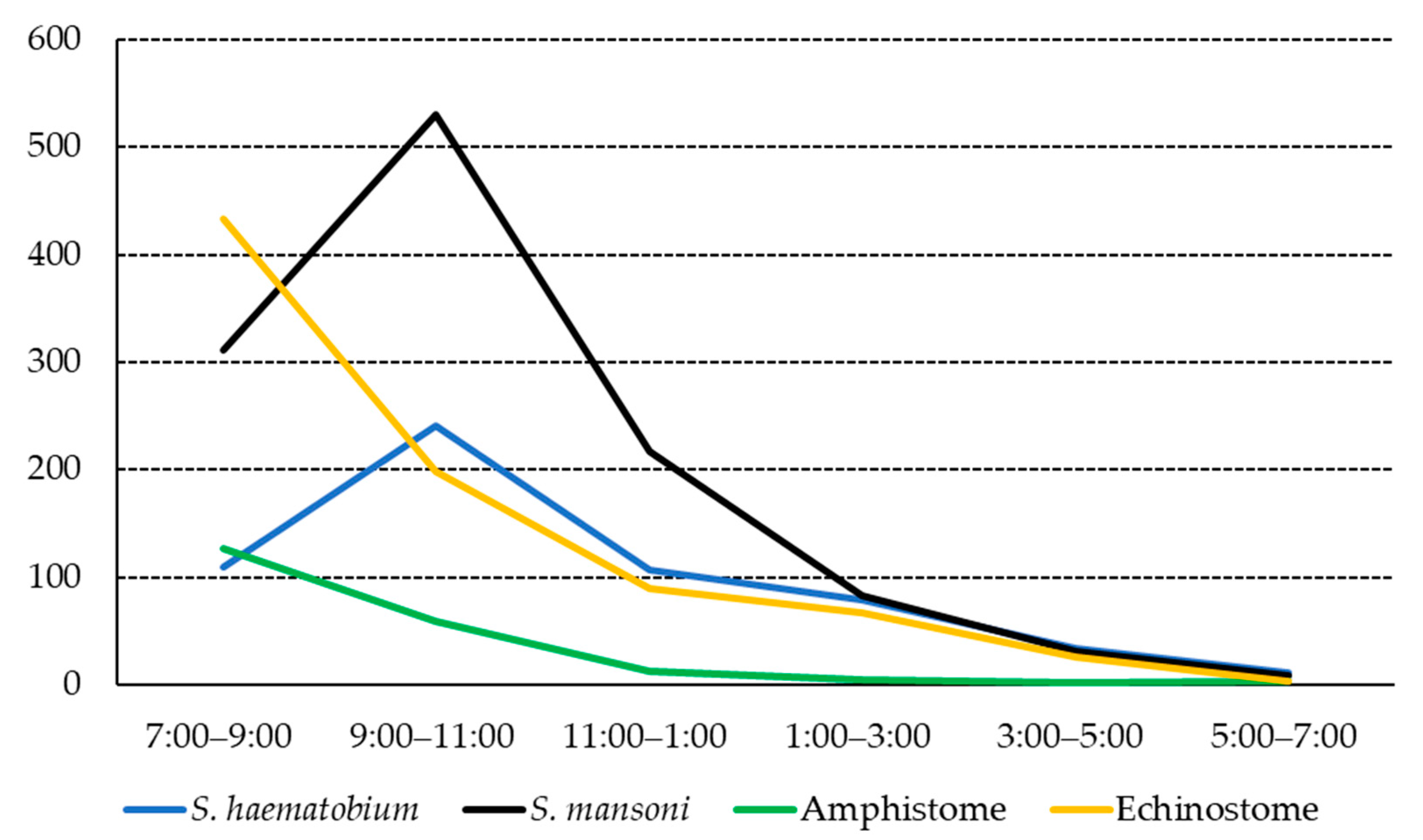
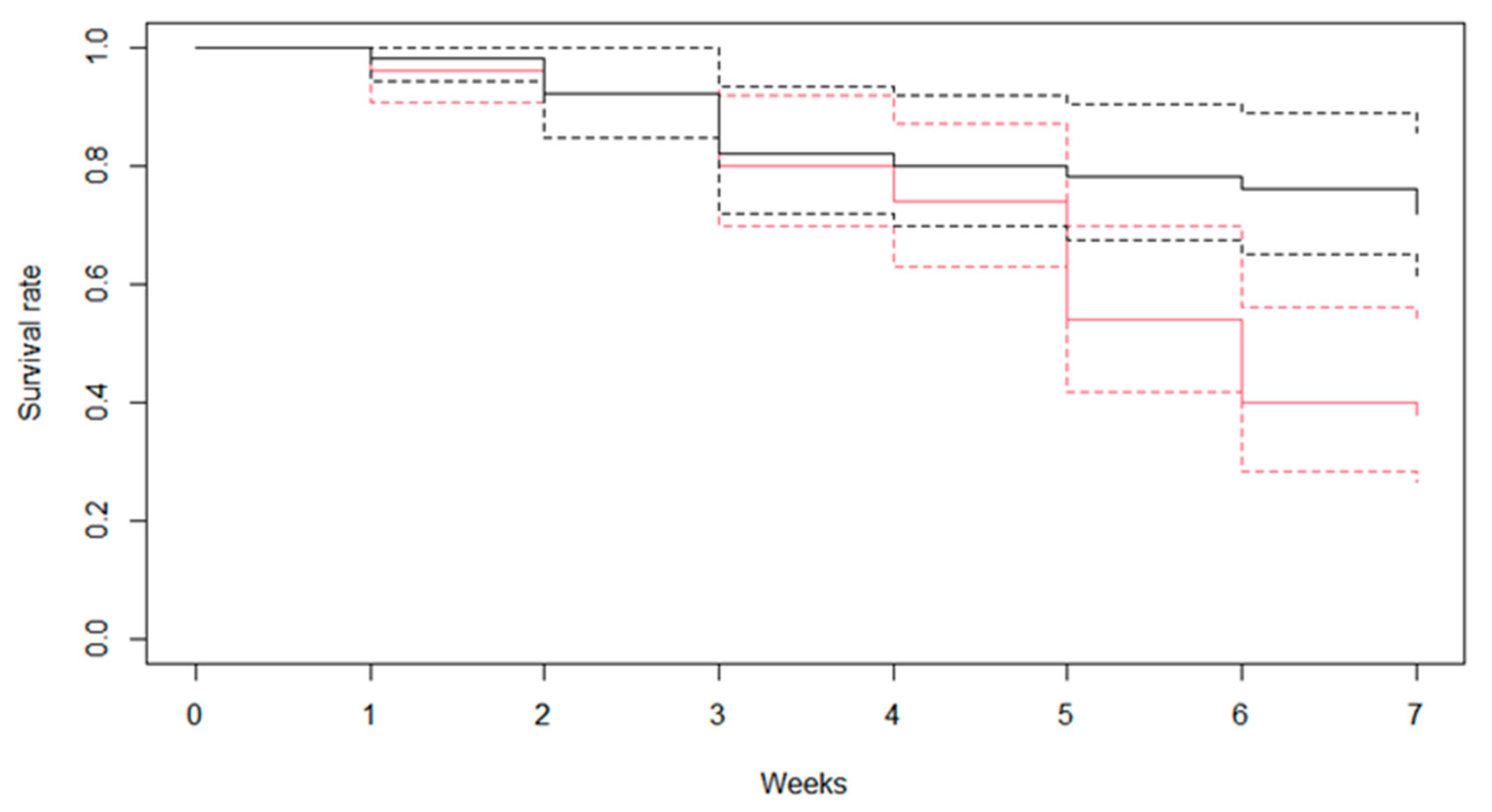
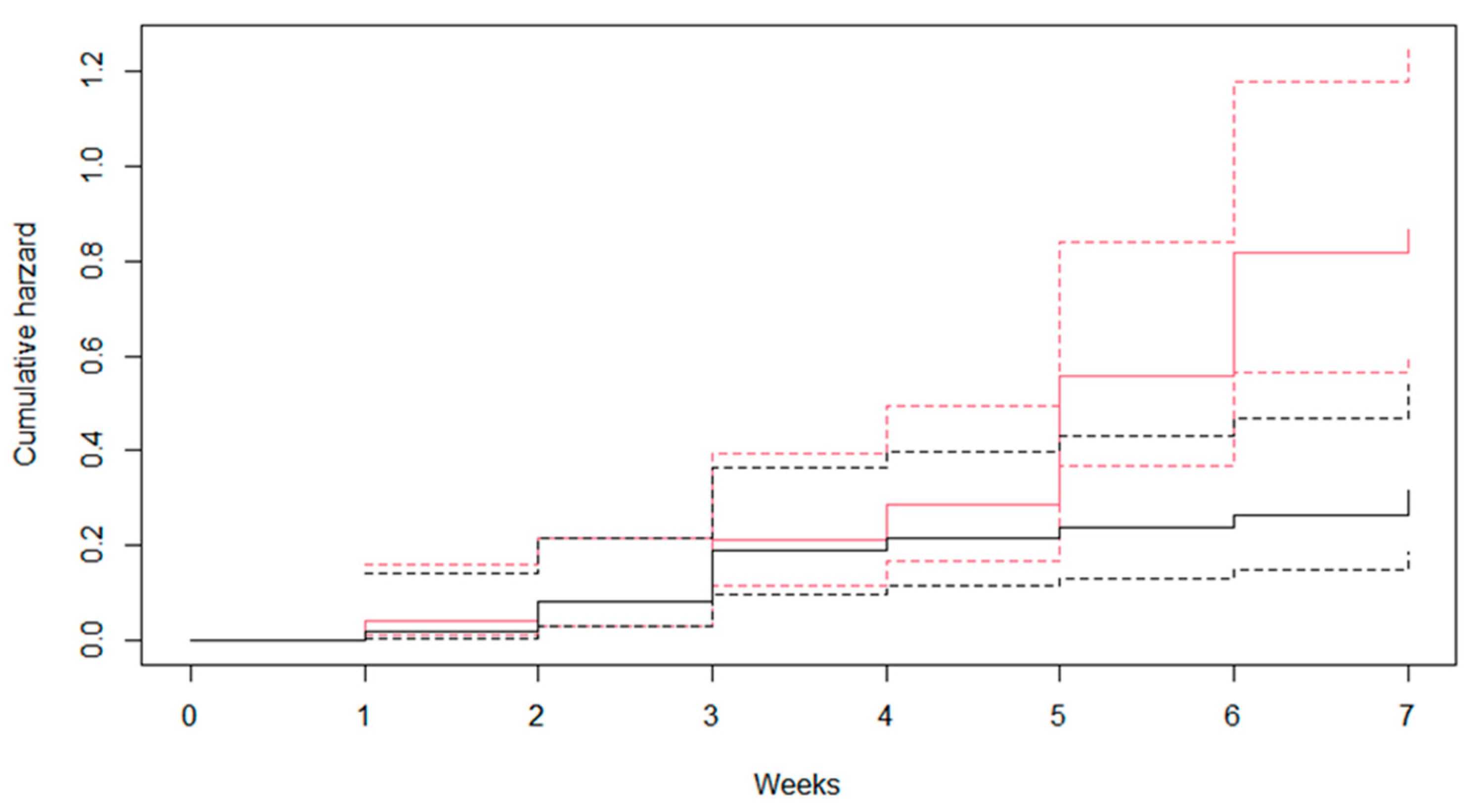
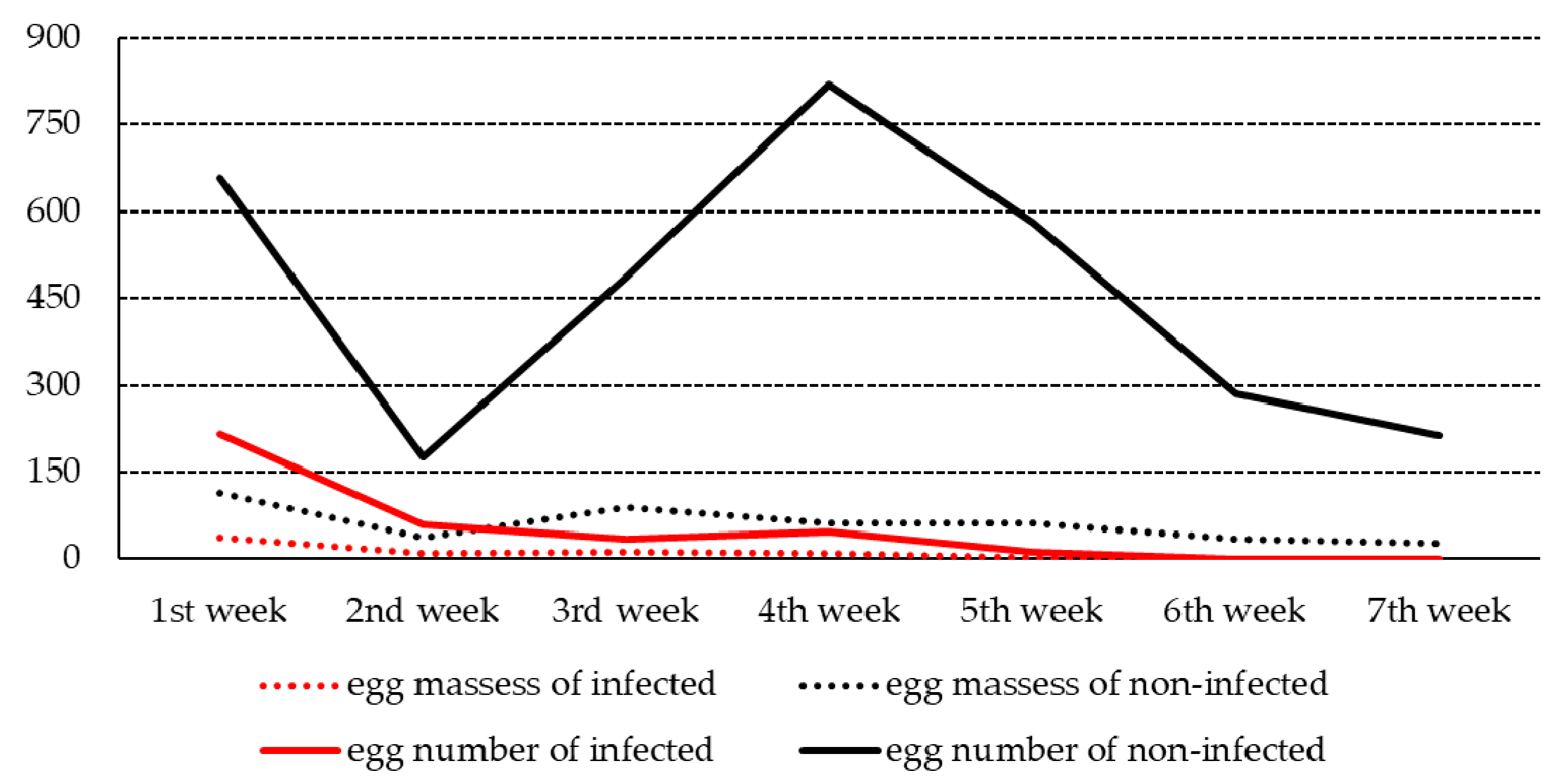
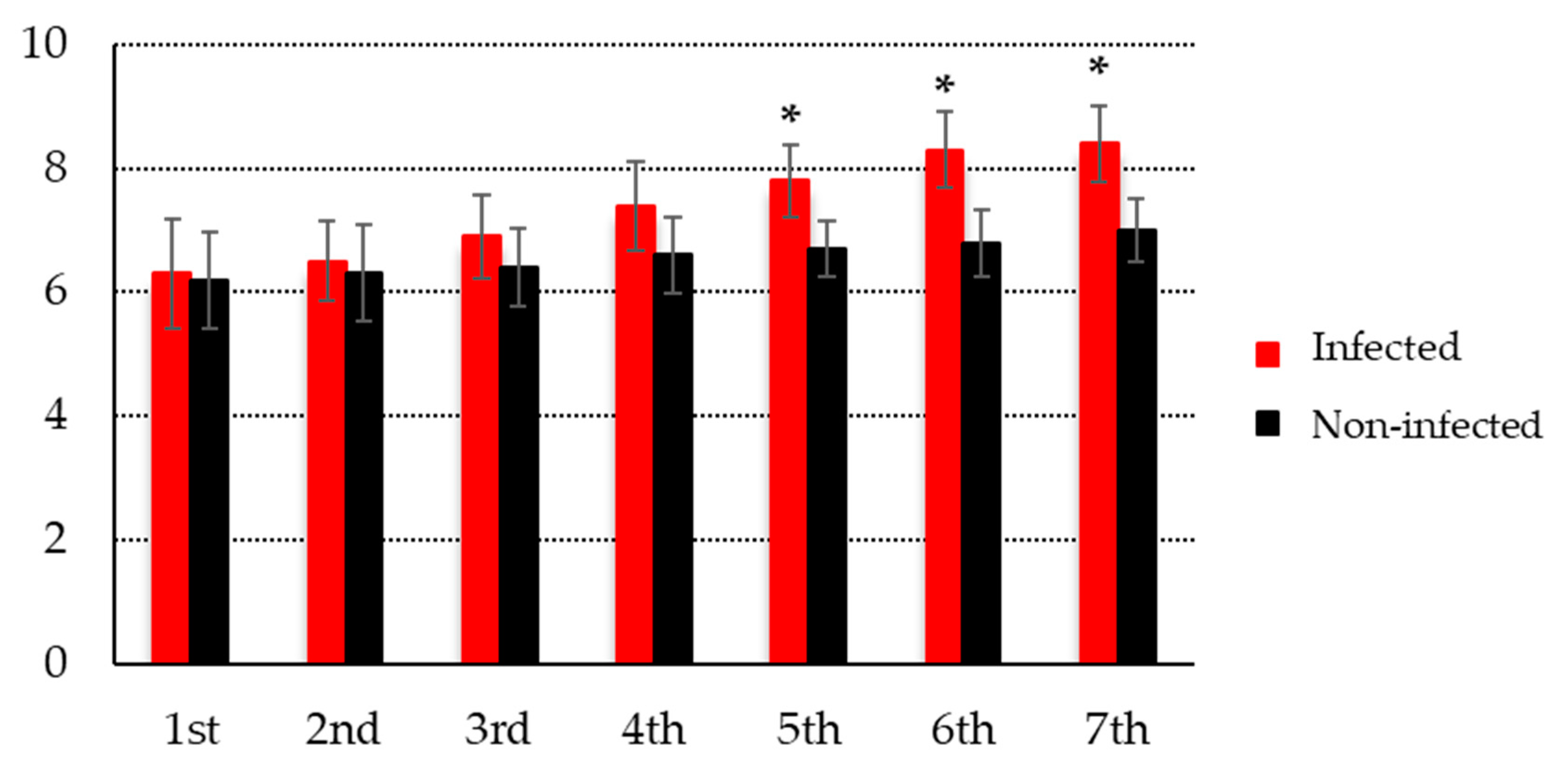
Publisher’s Note: MDPI stays neutral with regard to jurisdictional claims in published maps and institutional affiliations. |
© 2022 by the authors. Licensee MDPI, Basel, Switzerland. This article is an open access article distributed under the terms and conditions of the Creative Commons Attribution (CC BY) license (https://creativecommons.org/licenses/by/4.0/).
Share and Cite
Ismail, H.A.H.A.; Ahmed, A.e.A.A.e.R.M.; Cha, S.; Jin, Y. The Life Histories of Intermediate Hosts and Parasites of Schistosoma haematobium and Schistosoma mansoni in the White Nile River, Sudan. Int. J. Environ. Res. Public Health 2022, 19, 1508. https://doi.org/10.3390/ijerph19031508
Ismail HAHA, Ahmed AeAAeRM, Cha S, Jin Y. The Life Histories of Intermediate Hosts and Parasites of Schistosoma haematobium and Schistosoma mansoni in the White Nile River, Sudan. International Journal of Environmental Research and Public Health. 2022; 19(3):1508. https://doi.org/10.3390/ijerph19031508
Chicago/Turabian StyleIsmail, Hassan Ahmed Hassan Ahmed, Abed el Aziz Abed el Rahim Mohamed Ahmed, Seungman Cha, and Yan Jin. 2022. "The Life Histories of Intermediate Hosts and Parasites of Schistosoma haematobium and Schistosoma mansoni in the White Nile River, Sudan" International Journal of Environmental Research and Public Health 19, no. 3: 1508. https://doi.org/10.3390/ijerph19031508
APA StyleIsmail, H. A. H. A., Ahmed, A. e. A. A. e. R. M., Cha, S., & Jin, Y. (2022). The Life Histories of Intermediate Hosts and Parasites of Schistosoma haematobium and Schistosoma mansoni in the White Nile River, Sudan. International Journal of Environmental Research and Public Health, 19(3), 1508. https://doi.org/10.3390/ijerph19031508





